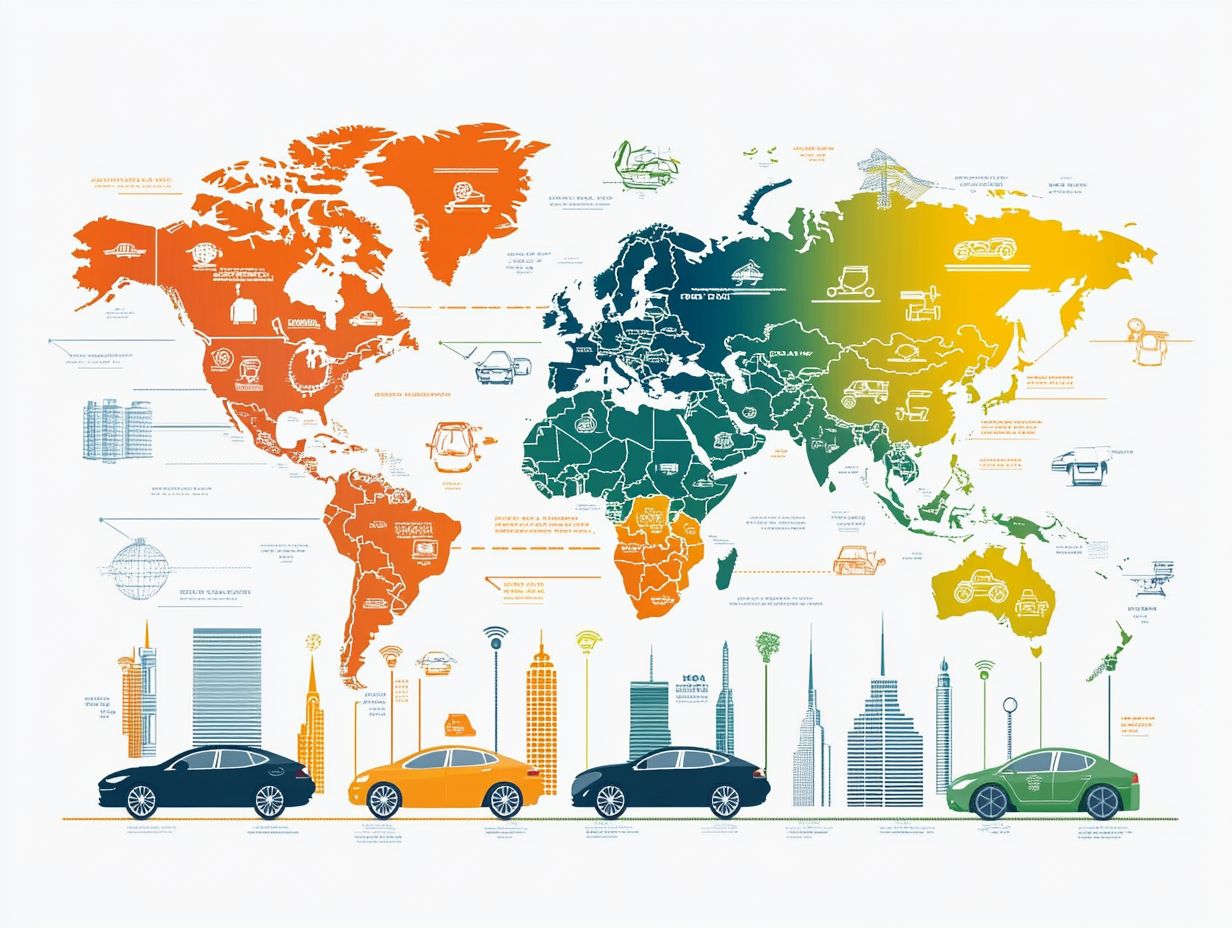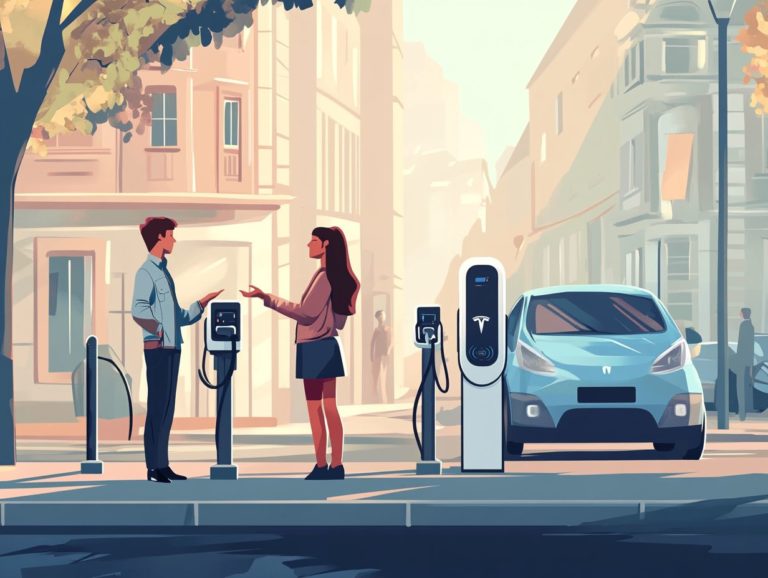Electric Vehicle Adoption Rates by Country
Electric vehicles (EVs) are redefining the automotive landscape, and you ll notice that adoption rates vary significantly around the globe. This exploration dives deep into the leading countries adopting EVs, revealing the exciting journey toward sustainable transportation!
Understanding these rates is essential, as they reveal not just consumer preferences but also the broader movement towards sustainable transportation. This exploration delves into the leading countries embracing EV adoption, along with the key factors that either propel or impede this transition. By examining the challenges and potential solutions, you ll explore the challenges and solutions to see what the future holds for electric mobility.
Immerse yourself in this journey into the dynamic world of electric vehicles.
Contents
Key Takeaways:

Overview of Electric Vehicle Adoption
Electric vehicle adoption stands at the forefront of sustainable transport, showing an important change to cut down greenhouse gas emissions and advancing climate objectives.
As nations increasingly acknowledge the significance of electric vehicle (EV) sales in curbing transportation emissions, it becomes essential for you to grasp the current trends, market dynamics, and consumer preferences that are shaping the electric vehicle landscape. Financial incentives and government support play a key role in boosting EV adoption, facilitating a seamless transition from traditional internal combustion engines to vehicles that do not produce any harmful emissions.
Definition and Importance of Adoption Rates
Adoption rates of electric vehicles (EVs) serve as a pivotal indicator of how swiftly the market is pivoting toward sustainable transportation solutions, influencing EV sales and electric car registrations across the globe.
As you embrace the advantages of eco-friendly transportation, these rates mirror shifting consumer attitudes and preferences insights that are invaluable for both manufacturers and policymakers. Increasing adoption rates don t just reflect growing confidence in electric mobility; they also act as a catalyst for essential infrastructure enhancements, such as the expansion of charging stations and the development of energy-efficient technologies.
This fast-changing landscape opens up exciting new choices for you. Elevated adoption rates spur automakers to channel more investment into innovative EV models, ultimately molding market trends and paving the way for a cleaner, greener future.
Top Countries for Electric Vehicle Adoption
When you explore the landscape of electric vehicle adoption, countries such as Norway, China, Sweden, Iceland, and the Netherlands emerge as prominent leaders in the EV market.
These nations demonstrate astonishing growth in electric car registrations and adoption rates, setting a compelling example for others to follow.
Ranking and Comparison of Adoption Rates

A comprehensive ranking and comparison of electric vehicle adoption rates reveals intriguing disparities in EV sales across various countries. Insights from international energy reports shed light on the leading markets and their distinct characteristics, including electric vehicle adoption in developing countries.
Take Norway, for example. It emerges as a global frontrunner, showcasing an impressive percentage of its new car sales as electric vehicles, largely fueled by robust government incentives and an extensive charging infrastructure. On the flip side, the United States displays a mixed performance. Here, significant state-level initiatives drive certain regions to embrace electric mobility with greater enthusiasm, illustrating how local policies can shape outcomes.
Factors such as income levels, public awareness, and the strength of the automotive industry play crucial roles in these variations. This means that electric vehicle adoption is not merely a matter of consumer preference; it also reflects broader socio-economic frameworks at play.
Are you ready to join the electric revolution? Discover more about EV options today!
Factors Influencing Adoption Rates
The factors influencing electric vehicle adoption rates are both diverse and varied. You will find that economic factors, environmental benefits, government support, and the availability of charging stations all play crucial roles in shaping this landscape.
Economic, Environmental, and Governmental Factors
Economic factors, such as the total cost of ownership and battery costs, significantly influence your decision to adopt electric vehicles. Coupled with the environmental benefits that promote emissions reduction and government support providing financial incentives, these elements create a compelling case for making the switch.
These economic considerations are pivotal as they directly impact your purchasing choices. When you realize that the lifetime savings from fuel and maintenance costs can outweigh those of traditional vehicles, the allure of electric options becomes hard to resist.
The environmental consequences of transportation emissions are critical, especially as cities face air quality challenges and climate change. Governments recognize this and are implementing policies that encourage sustainable mobility, including tax rebates and investments in charging infrastructure. This makes electric vehicles a must-consider choice for the eco-conscious consumer.
This combination of economic value, environmental responsibility, and supportive legislation paves the way for broader adoption of electric vehicles, so don t miss out on this revolution in transportation!
Challenges to Electric Vehicle Adoption
Despite the increasing enthusiasm surrounding electric vehicles, several challenges hinder their widespread adoption. Factors such as inadequate charging infrastructure, consumer perceptions, and the residual impact of fossil fuels on the transportation sector are significant barriers you must navigate.
Barriers and Solutions

Barriers to electric vehicle adoption like inadequate charging stations and limited public transit options demand strategic solutions to elevate the EV market and encourage infrastructure development.
These challenges can significantly obstruct your transition to sustainable transportation, especially if you live in urban areas where charging stations are few and far between. The high costs associated with batteries often create a financial hurdle, making electric vehicles seem less viable compared to their traditional counterparts.
To tackle these issues, many governments are exploring initiatives such as increased funding for charging facilities and tax incentives for those investing in EV technology. Collaborations with the private sector, including utility companies and tech firms, could pave the way for a greater number of charging stations. A notable example is California s Clean Vehicle Rebate Project, which seeks to make EVs more accessible to a wider audience.
Impact of Electric Vehicle Adoption on the Automotive Industry
The impact of electric vehicle adoption on the automotive industry is nothing short of transformative. You will notice significant shifts in electric vehicle production, market trends, and future predictions as traditional manufacturers navigate the S-curve growth of the EV market.
This evolution isn t just a trend; it s a fundamental restructuring of the industry that you need to know about.
Changes in Market Trends and Future Predictions
The electric vehicle market is on the rise and transforming how we think about transportation! Changes in market trends reveal a significant shift toward electric vehicles. Future predictions highlight cost savings as production increases, declining battery costs, and enhanced policies that will further fuel adoption.
These trends suggest a broader acceptance of electric vehicles among consumers. They also indicate significant impacts for infrastructure development, including the expansion of charging stations and the need for grid reliability, which refers to the ability of the power grid to handle demand and supply efficiently.
It’s essential to recognize the influence of governmental regulations, particularly in major markets. The incentives crafted to accelerate the transition to electric mobility are truly pivotal.
Technological advancements, such as breakthroughs in battery technology and improved software integration for electric vehicles, play a crucial role in making these innovations more accessible while optimizing performance. Together, these factors are shaping a dynamic landscape, compelling manufacturers to invest heavily in research and development to meet the growing demand.
Frequently Asked Questions
Curious About Electric Vehicle Adoption Rates?

The current global electric vehicle adoption rate by country is approximately 4.2%. This means that 4.2% of all vehicles on the road are electric vehicles.
Which country leads in electric vehicle adoption?
Norway currently has the highest electric vehicle adoption rate, with electric vehicles accounting for 16.2% of all vehicles on the road.
What influences electric vehicle adoption rates?
Several factors contribute to differences in electric vehicle adoption rates among countries. These include government incentives, the availability and accessibility of charging infrastructure, and consumer attitudes towards electric vehicles.
How do adoption rates vary by region?
The adoption rate of electric vehicles varies significantly by region. For example, European countries tend to have higher adoption rates compared to other regions, while developing countries may have lower rates due to economic and infrastructural challenges. To understand these differences better, you can explore how the electric vehicle market compares globally.
What are the benefits of increased electric vehicle adoption?
Higher electric vehicle adoption rates can lead to reduced emissions and air pollution, decreased reliance on fossil fuels, and improved public health. They can also create new jobs in the green energy sector and stimulate economic growth.
Will electric vehicle adoption continue to rise?
It is expected that electric vehicle adoption rates will continue to increase in the future. More governments and consumers are prioritizing sustainability, and the technology behind electric vehicles continues to improve. Now is the time to embrace electric vehicles!






